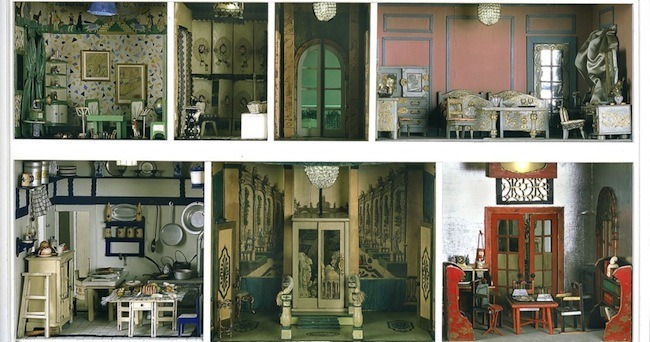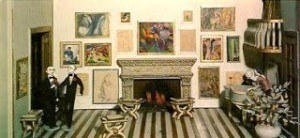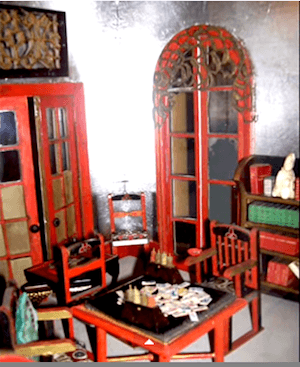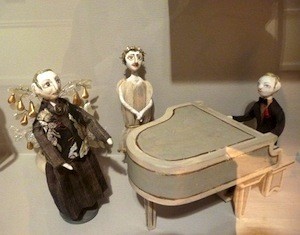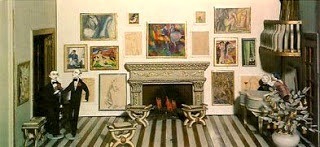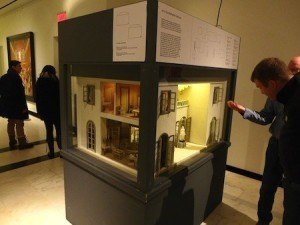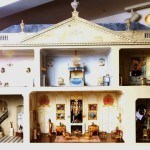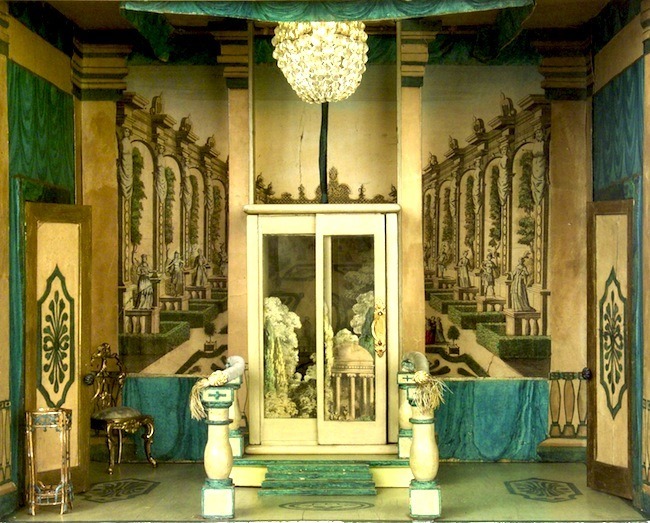 Stettheimer Dollhouse Foyer and Glass Elevator found on MonopolThe First Dollhouse
Stettheimer Dollhouse Foyer and Glass Elevator found on MonopolThe First Dollhouse
The Stettheimer Dollhouse
Saranac Lake in the Adirondacks was a favorite watering hole of the New York City rich and famous. In the summer of 1916, the upper-class children had a fund-raising bazaar to benefit local children affected by a polio epidemic. Some pestered their parents for contributions, others pestered the neighbors. Carrie Stettheimer, the youngest of three daughters, got wooden boxes from a grocer and created a dollhouse with found objects and scraps. When the family returned home to their West 58th Street mansion, Carrie began her life-long work – The Stettheimer Dollhouse.
The Salon
A common definition of a salon is “a recurring assembly of guests in a private home, usually consisting of the leaders the arts, society, and politics. Rosette Stettheimer, the matriarch of the family, presided over their “salon,” and the guest list was skewed towards artists and high- society members who loved to rub elbows with Greenwich Village bohemians. That may be why at Carrie Stettheimer’s death in 1944, the dollhouse she started in the Fall of 1916 was unfinished.
Rosette’s three amazingly gifted, never-married daughters were always in attendance at the salons. Florine the artist, Ettie the writer, and Carrie, whose pleasures were reading, learning and conversation. Ettie wrote that “these pleasures were so time-consuming Carrie scarcely had time for working on her dollhouse.”
The Guest List
The Stettheimers were active in the art world of the 1920s and 30s. And not as dilettantes. Florine and Ettie were accomplished in their chosen fields. Carrie was smart and charming and working on her own piece of art.
Regular guests at the salons included figures from the country’s first avant-garde, artists, and writers like Marcel Duchamp, Man Ray, Marsden Hartley, Carl Van Vechten, Gaston Lachaise, Alfred Stieglitz, Georgia O’Keeffe, Pavel
Tchelitchew, Virgil Thomson, Gertrude Stein and many others.
The Dollhouse
Carrie Stetteimer intended the dollhouse to be a near replica of the family home, even down to the decorations and furnishings. She painstakingly recreated every detail of the mansion’s interior design. Each room is lush in detail and color.
The dollhouse is large, more than four feet long and three feet high. There used to be little plaster figurines of some of the salon’s famous visitors, but they’re gone now. Most everything else is in place. The foyer is a bright yellow-gray-malachite-green fantasy with tiny silver and gold topiary trees in white urns. There are cellophane curtains tied with cherry-colored ribbons. And the red carpet and enclosed elevator with formal floral bouquets. The nursery is papered with one of Carrie’s collages and a dreamy frieze of Noah’s ark.
The kitchen is properly equipped with tiny pots and pans; the linen room linen sheets and woolen blankets. The bedroom has Limoges vases and blue taffeta drapery.
Then there’s the ballroom with a powder-blue piano, neoclassical fireplace, and a gold-and-white wooden floor. Wow!
The Art Collection
Perhaps the most notable feature of the dollhouse is its art collection. Many of the Stettheimer friends made tiny copies of their paintings and sculptures for the dollhouse. Marcel Duchamp made a miniature Nude Descending a Staircase; Gaston Lachaise’s his statue Nude Woman; even smaller nudes by Marguerite Zorach and Alexander Archipenko. There’s a micro-cubist portrait by Albert Gleizes and William Zorach’s thumb-sized bronze Mother and Child.
Gift To New York City
After her mother’s death in 1935, Carrie stopped working on the dollhouse and some rooms were left unfinished. Her sister Ettie (who survived both Florine and Carrie) donated the dollhouse to the Museum of the City of New York in 1945. She arranged for the unfinished rooms – Art Gallery and Dining Room – to be completed as she thought her sister would have wanted them.
If you want to delve deeper into the fascinating art world in which the Stettheimer sisters dwelled, the article “Florine Stettheimer ~ Contemporary of Duchamp, O’Keeffe, and Stein” is a “must-read.” Here’s a link to the Wednesday, November 25, 2009, post on the Fifty Two Pieces blog. Scroll down to the third article.
Other artists who created works for the Dollhouse include Alexander Archipenko, George Bellows, Gaston Lachaise, and Marguerite Zorach.
And the Stettheimer Dollhouse video by Ileana Ottini is terrific.
Susan Downing, with Patrick Owens


